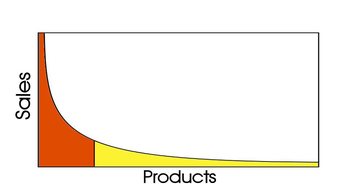Peer-to-peer search
Posted on Fri, Mar 24, 2006 at 6:40 PM by Andrew ChadwickA very intriguing development in the world of search, and the shape of things to come in terms of the anti-Google backlash?
A very intriguing development in the world of search, and the shape of things to come in terms of the anti-Google backlash?
Fascinating and quite depressing story in the New York Times about Wal-Mart fighting back by using bloggers to feed other bloggers positive facts about the company.
Good little article by Ellen Perlman in Governing Magazine about the rise of blogs and wikis in US state and local governments.

The theory of the 'long tail' is that online commerce and distribution is changing the economics of the media and entertainment industries. Ever wondered why a city center cinema, record store or bookseller has so few titles? It boils down to this: traditionally, movie studios, publishers and record companies tend to try (it doesn't always work) to create small numbers of 'big hit' products because the sunk costs of developing a film, book, or album can be more quickly and predictably recouped. Similarly, real space retail outlets (cinemas, city center record stores, booksellers) can only afford to sell 'hit' products because the relatively high cost of providing shelf or screen space for low-selling niche products makes it risky.
The long tail idea is that online distribution significantly reduces these costs, resulting in a sales/products curve like the one above. Because consumers can now be presented with a hugely expanded range of products, businesses can be built upon many products that have low sales, not just the traditional model - few products that have high sales.
Chris Anderson, a journalist, has been blogging the topic in the run-up to the publication of a new book on the subject in June 2006. Anderson writes:
'The theory of the Long Tail is that our culture and economy is increasingly shifting away from a focus on a relatively small number of "hits" (mainstream products and markets) at the head of the demand curve and toward a huge number of niches in the tail. As the costs of production and distribution fall, especially online, there is now less need to lump products and consumers into one-size-fits-all containers. In an era without the constraints of physical shelf space and other bottlenecks of distribution, narrowly-target goods and services can be as economically attractive as mainstream fare.
One example of this is the theory's prediction that demand for products not available in traditional bricks and mortar stores is potentially as big as for those that are. But the same is true for video not available on broadcast TV on any given day, and songs not played on radio. In other words, the potential aggregate size of the many small markets in goods that don't individually sell well enough for traditional retail and broadcast distribution may rival that of the existing large market in goods that do cross that economic bar.
The term refers specifically to the yellow part of the sales chart at upper left, which shows a standard demand curve that could apply to any industry, from entertainment to hard goods. The vertical axis is sales; the horizontal is products. The red part of the curve is the hits, which have dominated our markets and culture for most of the last century. The yellow part is the non-hits, or niches, which is where the new growth is coming from now and in the future.
Traditional retail economics dictate that stores only stock the likely hits, because shelf space is expensive. But online retailers (from Amazon to iTunes) can stock virtually everything, and the number of available niche products outnumber the hits by several orders of magnitude. Those millions of niches are the Long Tail, which had been largely neglected until recently in favor of the Short Head of hits.
When consumers are offered infinite choice, the true shape of demand is revealed. And it turns out to be less hit-centric than we thought. People gravitate towards niches because they satisfy narrow interests better, and in one aspect of our life or another we all have some narrow interest (whether we think of it that way or not).'
Why is this significant? Well, there are several reasons, but I have categorized this post under the 'political economy of Internet media' heading because I think it says something new and very interesting about how the Internet contributes to a more diverse and pluralistic media landscape. Long tail trends in the media industries mean that minority niche products stand more of a chance of finding a market.
At the same time, though, there is one problematic aspect.
It would be interesting to find out how many products that qualify as 'long tail' are actually the product of divisions and subdivisions of large media and entertainment conglomerates. There may be a case for arguing that the long tail is exaggerated because there is greater product diversity but not greater structural diversity in the market. It could be that the arbiters of taste remain a small but powerful elite, it's just that they're employing a more segmented approach. An illustration of this is News Corporation's recent acquisition of MySpace.
I've had a quite a few emails over the past couple of weeks from people asking about the publication schedule of the book. In short, it published in the US on February 23rd, but the UK/EU publication date was for some reason set for April. However, it appears that Blackwells in the UK is now selling it at the UK price for delivery in 3-9 days.